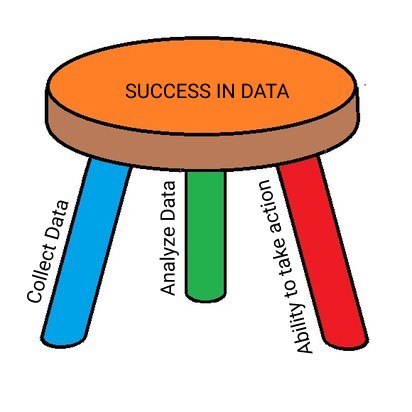
Data is only useful if it can be understood. If we don’t understand it, we won’t be able to act on it. If we won’t be able to act on it, it is worthless.
Though data cannot solve problems, it can help us to identify and understand them.
Getting success through data is dependent upon the three-legged stool. If you remove any one leg, the stool falls down.

1. Collect Data-
The first essence of data analysis is capturing the data. For this, we need to know the potential data streams available to build the most accurate and complete outcomes for decision-making.
At this stage, we should be asking questions like-
- Where will the data come from that we’ll use?
- What other metrics — beyond the KPIs — will we need to capture?
- What additional data considerations need to be factored into the effort to ensure that we are positioned for effective analysis and optimization down the road?
- What (if any) special tagging, tracking, or monitoring do we need to put into place (and who/how will that happen)?
- What are the known limitations of the data?
- What are our assumptions about the effort? …and more
It is important to have a neutral presentation of facts. If if we have limited focus, it will provide an incomplete and biased view.
2. Analyse Data-
At this stage, encoding takes precedence over decoding. The analysis requires some prerequisite plan or prerequisite action.
For the prerequisite plan, we already have a purpose for collecting the data. It is to help discover more ‘unknown knowns’.
“Why the new visitors are not signing up on our website?”
“Why the users are not able to see the videos?”
“Are users facing issues in signing up?”
For prerequisite action, we have the historical data and now we are changing the future execution to test how the results change. It is to help discover more ‘known unknowns’.
“We have added a section on how our product will help the users. Is it resulting in more new users sign-up?”
“We have added Youtube URL. Is it resulting in more views of the videos?”
“We have changed the sign-up process, is it helping more users now in signing up on our website?”
It is important to capitalize on the new insights gained from theses data.
3. Ability to take action
The last important step is that data should be providing some actionable insights. Many big companies have tons of data and tons of customer insights which they use to their advantage and create groundbreaking products. e.g. Spotify offers every user a personalized playlist with music recommendations based on their listening and browsing history. This feature is possible due to the abundance of data they are collecting from their user base with the help of which they have gained pretty deep insights into their users’ habits and preferences.
As designers, we have a mass of opportunities in front of us to fundamentally rethink how we work with data, and how we drive meaning and insights from it. We should use these opportunities to make better design decisions, ultimately creating better products for our users.
References:
3-Legged Stool of Effective Analytics: Plan, Measure, Analyze – Analytics Demystified
https://blog.adobe.com/en/publish/2017/05/10/the-importance-of-data-in-design.html#gs.y7gjdo
Three-legged stool for Success in Data was originally published in UX Planet on Medium, where people are continuing the conversation by highlighting and responding to this story.